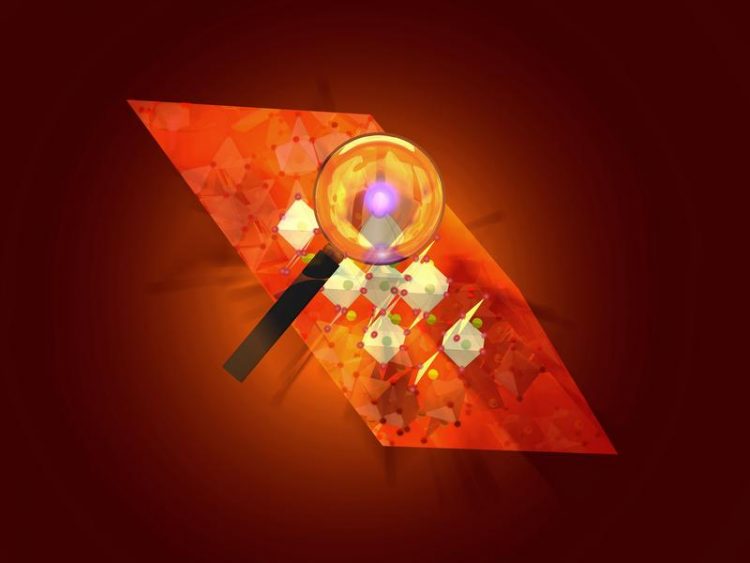Good vibrations feel the force

Strong-field mid-infrared excitation allows to drive lattice vibrations of a crystal into the highly anharmonic regime. Here, the atoms oscillate not only at their fundamental frequency but also at overtones, so called higher harmonics. The measurement of this atomic motion far away from equilibrium allows to reconstruct the interatomic potential. Copyright: Joerg Harms, MPSD
By measuring the highly unusual atomic trajectories under extreme electromagnetic transients, the MPSD group could reconstruct how rigid the atomic bonds are at large distances from the equilibrium arrangements. This promises new insights into the mechanical properties of matter and their instability near phase changes.
Crystals are held together by extremely strong forces, which determine all their thermal and mechanical properties. The temperature at which a specific material melts or changes shape and the material's resistance to pressure and shear distortions are all determined by this ‘force field’.
It is the basis of any textbook description of a material and is routinely calculated by sophisticated theoretical methods. Still, until now no experiment could quantitatively validate these calculations or at least measure the force field.
In a recent study by the MPSD group led by Andrea Cavalleri, ultrashort laser flashes at mid-infrared frequencies were used to move atoms far away from their equilibrium arrangement. By measuring how the same atoms were made to ring after the impulse had been turned off, the MPSD research group could reconstruct the nature of the forces that hold the crystal together.
“We use strong laser fields to drive the atoms to displacements where their dynamics can no longer be described within the harmonic approximation,” explains Alexander von Hoegen, doctorate at the MPSD and first author of this paper. “In this situation, the restoring forces acting on the atoms are no longer linear proportional to the displacements from the equilibrium positions, as they would be in the case of small oscillations in a pendulum.”
Such nonlinear phononics is for example manifested by the fact that the atoms not only oscillate at their natural frequency, but also at multiple overtones, the so-called higher harmonics observed in this study.
The corresponding atomic displacements, enormous on the scale of the interatomic distances, are nevertheless only of the order of a few picometers, that is a millionth of a billionth of a meter. The vibrations were traced with a second, even shorter laser pulse.
Although the atoms were found to oscillate with speeds beyond 1000 m/s, their motion could be traced in ultra-slow motion. This time-resolved measurement was key to reconstructing the forces acting on the atoms.
This work by the MPSD establishes a new type of nonlinear spectroscopy that captures one of the most fundamental microscopic properties of materials, underscoring the power of new advanced optical sources and paving the way to a future, even more insightful class of experiments at the Hamburg X-ray Free Electron Laser.
The paper was made possible through the ERC Synergy Grant “Frontiers in Quantum Materials’ Control” (Q-MAC), the excellence cluster “The Hamburg Centre for Ultrafast Imaging (CUI), as well as the SFB project “Light Induced Dynamics and Control of Correlated Quantum Systems”.
Reference:
Probing the interatomic potential of solids with strong-field nonlinear phononics
A. von Hoegen, R. Mankowsky, M. Fechner, M. Först & A. Cavalleri
Nature, online, 21. Feb. 2018
DOI: 10.1038/nature25484
Extended figure caption:
Strong-field mid-infrared excitation allows to drive lattice vibrations of a crystal into the highly anharmonic regime. Here, the atoms oscillate not only at their fundamental frequency but also at overtones, so called higher harmonics. The measurement of this atomic motion far away from equilibrium allows to reconstruct the interatomic potential. Copyright: Joerg Harms, MPSD
Contacts:
Alexander von Hoegen
+49-(0)40-8998-6551 / alexander.von-hoegen@mpsd.mpg.de
Prof. Andrea Cavalleri
+49 (0)40 8998 5354 / andrea.cavalleri@mpsd.mpg.de
Jenny Witt
Kommunikation und Öffentlichkeitsarbeit
+49 (0)40 8998-6593 / pr@mpsd.mpg.de
https://dx.doi.org/10.1126/science.aan3438 Originalpublikation
http://qcmd.mpsd.mpg.de/ Webseite der Forschungsgruppe um Prof. Andrea Cavalleri
Media Contact
All latest news from the category: Physics and Astronomy
This area deals with the fundamental laws and building blocks of nature and how they interact, the properties and the behavior of matter, and research into space and time and their structures.
innovations-report provides in-depth reports and articles on subjects such as astrophysics, laser technologies, nuclear, quantum, particle and solid-state physics, nanotechnologies, planetary research and findings (Mars, Venus) and developments related to the Hubble Telescope.
Newest articles

First-of-its-kind study uses remote sensing to monitor plastic debris in rivers and lakes
Remote sensing creates a cost-effective solution to monitoring plastic pollution. A first-of-its-kind study from researchers at the University of Minnesota Twin Cities shows how remote sensing can help monitor and…

Laser-based artificial neuron mimics nerve cell functions at lightning speed
With a processing speed a billion times faster than nature, chip-based laser neuron could help advance AI tasks such as pattern recognition and sequence prediction. Researchers have developed a laser-based…

Optimising the processing of plastic waste
Just one look in the yellow bin reveals a colourful jumble of different types of plastic. However, the purer and more uniform plastic waste is, the easier it is to…


